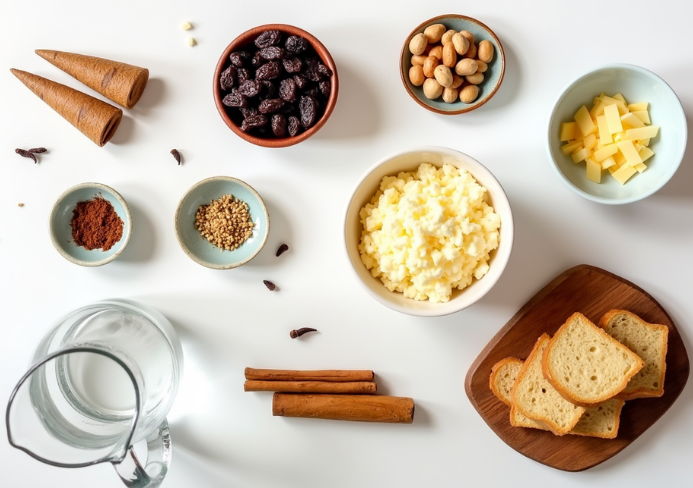Mexican Capirotada: The Sweet Tradition of a Cultural Bread Pudding
Mexican Capirotada is more than just a dessert—it’s a cultural symbol, a religious tradition, and a nostalgic memory baked into a dish. Typically prepared during Lent, especially on Good Friday, this Mexican bread pudding holds deep meaning for many families across generations. Let’s dive into the origins, recipe, variations, and symbolism behind this rich, spiced dish.
Table of Contents
Introduction to Capirotada
Capirotada is a traditional Lenten dessert made from layers of toasted bread, dried fruits, nuts, cheese, and a syrup infused with piloncillo, cinnamon, and cloves. Though it’s categorized as a bread pudding, its complexity and cultural roots make it a standout in the realm of Latin American cuisine. Each bite of Capirotada is steeped in both flavor and spiritual meaning.
The Historical and Religious Significance
The roots of Capirotada trace back to Spain, with its current form evolving during colonial times in Mexico. Initially, it was a savory dish, but over time, with the incorporation of native Mexican ingredients like piloncillo, it transformed into a sweet staple for Lent.
During the Catholic season of fasting and reflection, this dish was created as a way to use up leftovers, particularly bread, without consuming meat. Its ingredients carry deep religious symbolism:
- Bread represents the body of Christ
- Syrup (from piloncillo) symbolizes his blood
- Cloves signify the nails of the crucifixion
- Cinnamon sticks represent the cross
- Cheese embodies the holy shroud
According to Catholic News Agency, many foods consumed during Lent are crafted to reflect religious themes, making Capirotada a sacred culinary ritual in many homes.
Traditional Ingredients and Their Symbolism
Every component in a traditional Capirotada recipe serves both a practical and symbolic purpose. Here’s what you’ll often find:
- Bolillo or stale French bread, toasted
- Piloncillo (unrefined Mexican cane sugar)
- Cinnamon sticks and whole cloves
- Raisins and sometimes other dried fruits
- Roasted peanuts or other nuts
- Shredded cheese (often Monterey Jack or a mild white cheese)
Each ingredient is layered to not only build texture and flavor, but also to tell a story of faith, resilience, and tradition. The use of older bread highlights the frugality and creativity often tied to religious observance.
For a broader view of how such ingredients and traditions influence national identity, explore Mexican culinary traditions as documented by Smithsonian Magazine.
Regional and Family Variations of Capirotada
Capirotada is far from a one-recipe-fits-all dessert. Across Mexico and Mexican-American communities, you’ll find variations that reflect regional tastes and ingredients. Common changes include:
- Adding bananas, coconut, mango, or prunes
- Substituting dairy cheese with condensed or evaporated milk
- Incorporating tropical ingredients in coastal regions
- Including glazed fruits or candied nuts for extra sweetness
In northern Mexico, it’s common to find versions made without cheese, while central regions often prioritize a balance of sweet and savory. Many families also have a “Grandma’s recipe” passed down through generations, adding personal touches that make every dish unique.
Classic Capirotada Recipe Walkthrough
Here’s a simplified version of a classic Capirotada you can try at home:
Ingredients:
- 6 cups of water
- 3 cones of piloncillo
- 3 cinnamon sticks
- 3 whole cloves
- 1 cup raisins
- ½ cup roasted, salted peanuts
- 12 slices of toasted bolillo or French bread
- 2 cups shredded Monterey Jack cheese

Instructions:
- Preheat oven to 350°F.
- Simmer piloncillo, cinnamon, and cloves in water until syrupy.
- Toast the bread slices until golden and crisp.
- In a greased baking dish, layer bread, nuts, raisins, cheese.
- Pour syrup evenly over the layers.
- Bake for about 40 minutes or until bubbly and slightly crispy on top.
- Serve warm.
The layering technique is essential for creating that signature sweet-spicy-savory profile that defines Capirotada.
How to Serve and Store Capirotada
Capirotada is best enjoyed fresh and warm, but it’s also delicious the next day. Here’s how to make the most of it:
- Serve with a spoonful of whipped cream or vanilla ice cream for a modern twist.
- Store in an airtight container in the fridge for up to 4 days.
- Reheat in the oven or microwave to restore its comforting texture.
Modern Twists on the Classic Dessert
As tastes evolve and dietary needs shift, many cooks have adapted Capirotada to fit different lifestyles. Consider trying:
- Vegan Capirotada: Swap cheese with plant-based cheese and use maple syrup or agave instead of piloncillo.
- Tropical version: Add fresh mango, coconut flakes, or pineapple.
- Gluten-free: Use gluten-free bread and ensure all other ingredients are certified gluten-free.
These versions maintain the spirit of the dish while offering something new to the table.
Nutritional Value and Dietary Considerations
While Capirotada is undeniably indulgent, you can adjust it for health-conscious eaters:
- Use whole-grain bread for added fiber.
- Reduce or skip the cheese to lower fat content.
- Limit the amount of piloncillo or replace with a natural sweetener.
Typical servings contain moderate calories and are rich in carbohydrates and sugar. It’s meant to be a treat—especially during a time of fasting or reflection.
Capirotada Around the World: Mexican Diaspora
In the U.S., especially in states like California, Texas, and Arizona, Capirotada remains a cherished link to heritage for many Mexican-American families. It’s commonly served during Lent at community events, church functions, and family gatherings.
Diaspora communities have preserved this culinary tradition while sometimes adding local flair. For example, the use of American cheese slices instead of traditional Mexican cheese is a common adaptation.
Tips for First-Time Capirotada Makers
- Don’t oversoak the bread; you want it moist but not soggy.
- Use stale bread—fresh bread falls apart.
- Balance your layers: every bite should include a bit of everything.
- Pre-toast the bread for a crunchy texture even after soaking.
- Taste the syrup before pouring to adjust the sweetness and spice.
FAQs About Capirotada
What does Capirotada mean in English?
It comes from the Spanish word “capirote,” which refers to a type of religious hood—connecting the dish to its religious roots.
Why is Capirotada eaten during Lent?
It’s a meatless, symbolic dish designed for spiritual reflection during the fasting season.
What is the history of Capirotada?
It evolved from Spanish bread puddings and was adapted with Mexican ingredients during colonial times.
Can Capirotada be made without cheese?
Yes. Many regional and vegan recipes skip the cheese entirely.
How long does Capirotada last in the fridge?
Up to 4 days, if stored in an airtight container.
Is Capirotada supposed to be sweet or savory?
Traditionally sweet with subtle savory elements from the cheese.
Mexican Capirotada: The Sweet Tradition of a Cultural Bread Pudding
- Total Time: 1 hour
- Yield: 8 servings 1x
- Diet: Vegetarian
Description
A simplified yet traditional Mexican capirotada featuring toasted bolillo, rich piloncillo syrup, peanuts, raisins, and melted Monterey Jack cheese. A sweet, savory, and spiced dessert perfect for Lent or any cozy occasion.
Ingredients
- 6 cups of water
- 3 cones of piloncillo (or 12 oz dark brown sugar)
- 3 cinnamon sticks
- 3 whole cloves
- 1 cup raisins
- ½ cup roasted, salted peanuts
- 12 slices of toasted bolillo or French bread
- 2 cups shredded Monterey Jack cheese
Instructions
- Preheat oven: Set to 350°F (175°C) and lightly grease a baking dish.
- Make the syrup: In a large saucepan, combine water, piloncillo, cinnamon sticks, and cloves. Bring to a boil, then reduce to simmer until syrupy (about 15–20 minutes). Strain and discard solids.
- Toast the bread: Slice and toast bolillo or French bread until crisp and golden on both sides.
- Layer the capirotada: In the greased dish, layer toasted bread slices, then sprinkle with raisins, peanuts, and shredded cheese. Pour syrup evenly over the layers. Repeat as needed.
- Bake: Bake uncovered for about 40 minutes, or until bubbling and slightly crispy on top.
- Serve: Enjoy warm as-is or with a scoop of vanilla ice cream or whipped cream.
Notes
Capirotada is traditionally enjoyed during Lent, but its warming flavor and symbolic ingredients make it a year-round favorite. Store leftovers in the fridge up to 4 days and reheat in the oven or microwave.
- Prep Time: 20 minutes
- Cook Time: 40 minutes
- Category: Dessert
- Method: Baked
- Cuisine: Mexican
Nutrition
- Serving Size: 1 portion
- Calories: 360
- Sugar: 28g
- Sodium: 200mg
- Fat: 15g
- Saturated Fat: 7g
- Unsaturated Fat: 6g
- Trans Fat: 0g
- Carbohydrates: 48g
- Fiber: 2g
- Protein: 10g
- Cholesterol: 25mg
Keywords: capirotada, traditional Mexican dessert, Lenten recipes, piloncillo bread pudding, Monterey Jack cheese, sweet and savory






